iPhone camera lenses can be replaced through professional or DIY methods. Professional repairs using genuine parts cost approximately $199 at Apple stores, while third-party services start around $89. DIY options cost $10-$30 but risk permanent damage and void warranties. Common signs of damaged lenses include consistently blurry photos, visible cracks, dark spots, and autofocus failures. The complexity varies by model, with newer iPhones requiring specialized tools and technical expertise for successful lens replacement. Further information reveals important quality and warranty considerations.
Key Takeaways
- iPhone camera lenses can be replaced through DIY methods or professional repair services.
- DIY lens replacement costs $10-$30 but risks permanent damage and voids warranty.
- Professional repairs cost $89-$499 and preserve warranty coverage with factory-quality results.
- Signs of damaged lenses include consistently blurry photos, visible cracks, and persistent dark spots.
- iPhone models have varying repair complexity, with newer models like the iPhone 14 Pro requiring specialized tools.
Understanding Iphone Camera Lens Design and Construction
The iPhone camera system represents a marvel of miniaturized optical engineering, combining multiple sophisticated elements into a remarkably compact design. The lens assembly typically consists of five to seven precisely arranged elements, with each surface featuring aspheric geometry to minimize optical aberrations while maintaining slim dimensions. This approach has evolved throughout Apple’s Design History, allowing for progressive improvements in image quality despite space constraints. The high-quality glass materials used in these lenses are carefully selected to enhance optical clarity and durability. The Material Properties of these components are carefully selected, primarily utilizing specialized plastic materials with varying refractive indices rather than traditional glass. These plastics enable mass production through advanced molding techniques while delivering superior optical performance. Each lens assembly includes additional components such as an infrared filter to protect the sensor, an aperture stop to control light entry, and in premium models, optical image stabilization mechanisms to reduce motion blur.
Signs Your Iphone Camera Lens Needs Replacement
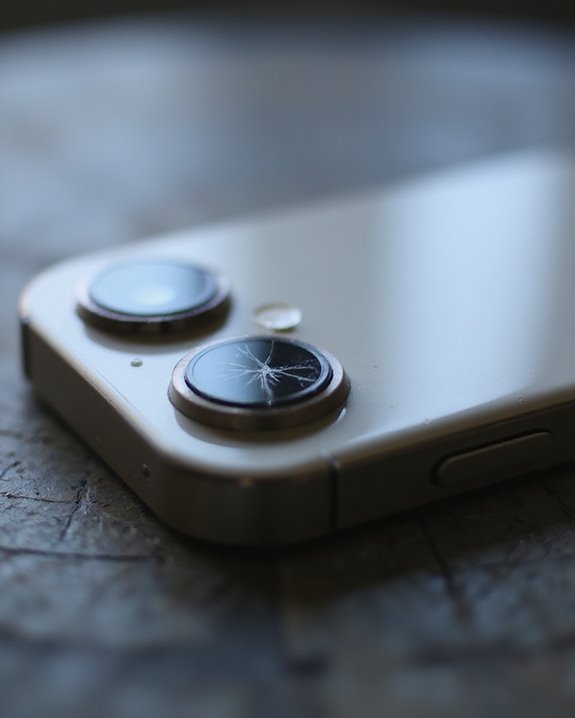
Recognizing signs of iPhone camera lens damage requires attentiveness to both visual cues and performance changes that develop over time. The most common damage indicators include consistently blurry photos despite good lighting conditions, visible cracks or chips on the outer glass, and persistent dark spots appearing in images.
When evaluating lens symptoms, users should inspect photos for light scattering effects, reduced contrast, or unusual flare patterns that weren’t previously present. Physical examination may reveal dust or moisture trapped behind the lens covering, signaling compromised integrity. Additionally, autofocus failures, where the camera struggles to lock onto subjects, often indicate underlying lens damage. It’s important to note that lens quality can significantly influence overall photo clarity and user experience.
Prompt replacement is essential, as continued use with damaged lenses can lead to sensor degradation, internal corrosion, and potentially necessitate replacing the entire camera module.
DIY Vs Professional Repair: Weighing Your Options
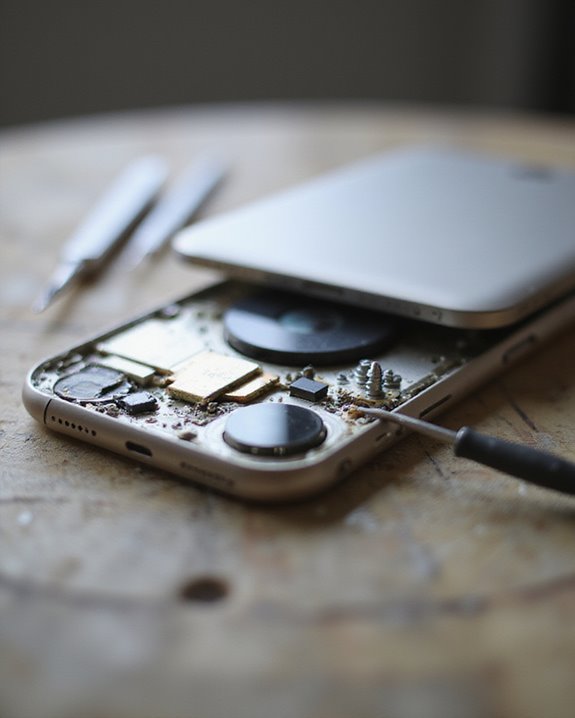
Once signs of camera lens damage become apparent, iPhone owners face an important decision: attempt a do-it-yourself repair or seek professional assistance. DIY repairs offer potential cost savings, with replacement parts ranging from $10-$30, but carry significant repair risks including permanent device damage and voided warranties when performed incorrectly. Using OEM kits with genuine sapphire glass and pre-installed adhesives can help ensure a factory-quality repair, reducing the risk of long-term issues.
Professional repairs, while more expensive at approximately $499 for complete camera modules, provide several advantages aligned with user preferences. These include access to genuine Apple parts, preservation of any remaining warranty, and expert handling of delicate components. The time commitment differs substantially between options, with DIY repairs potentially consuming several hours of self-study and execution, while professional services typically complete repairs within 2-3 business days after appointment scheduling.
Model-Specific Replacement Challenges and Solutions
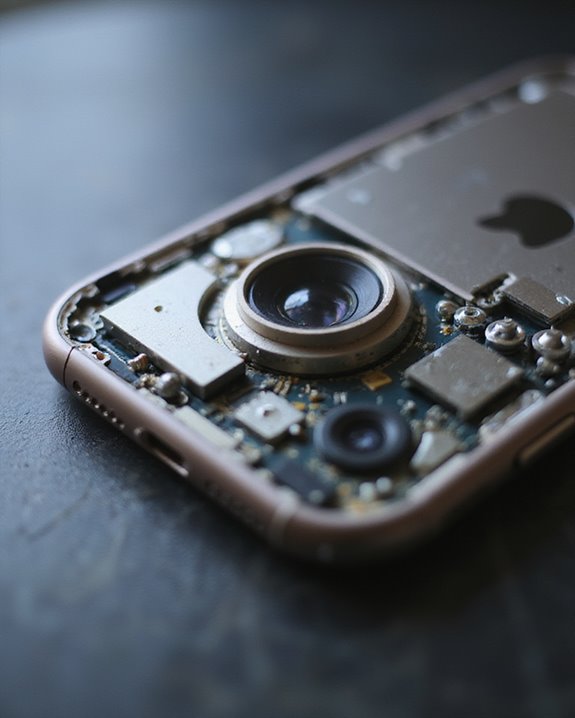
iPhone camera lens replacement varies greatly across different models, presenting unique challenges that require tailored solutions for each device generation. The iPhone 14 Pro and Pro Max, with their advanced camera arrays, demand specialized tools and technical expertise due to their intricate design and adhesive requirements.
Climate effects greatly impact repair procedures, as adhesives behave differently in various temperatures, necessitating controlled environments for best results. Additionally, accessory conflicts often complicate repairs, as third-party camera attachments or cases can interfere with proper lens installation or create unexpected alignment issues. Technicians must consider these factors when performing replacements.
Professional repair services typically have model-specific protocols that address these challenges, utilizing precise heating techniques to manage adhesives and specialized instruments to handle the increasingly complex camera assemblies found in newer iPhone models.
Tools and Materials Required for Camera Lens Replacement

The proper set of tools and materials stands as the foundation for any successful iPhone camera lens replacement, ensuring both efficiency and safety throughout the repair process. Essential tools include precision screwdrivers, spudgers, tweezers, suction cups, and brush tools, which should be arranged with careful Tool Organization on a magnetic project mat to prevent loss of tiny components.
Material Sourcing becomes critical when selecting replacement lenses, adhesives, and protective films, as these must be compatible with specific iPhone models. A well-lit, clutter-free workspace facilitates precise handling of delicate parts, while a thorough repair guide provides essential reference information during disassembly and reassembly. Purchasing high-quality tools and materials from reputable sellers, though potentially more expensive initially, ultimately reduces the risk of damage to the device.
Step-by-Step Lens Replacement Guide
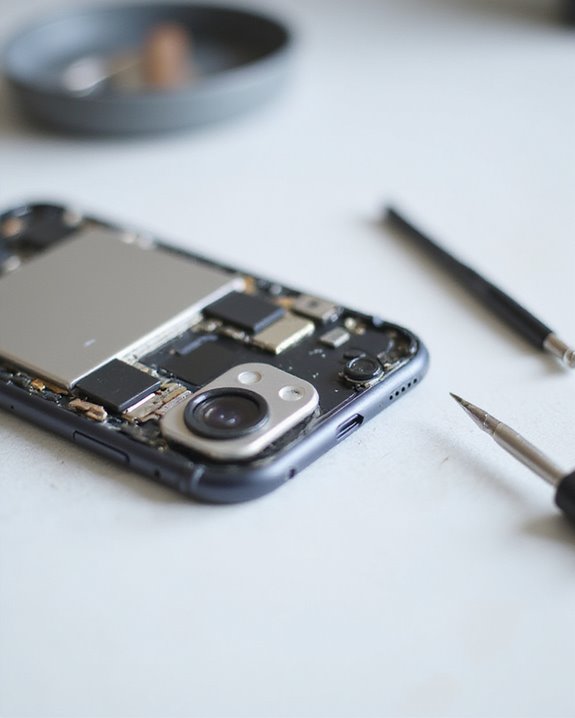
Armed with the right tools and quality replacement parts, technicians and ambitious DIY enthusiasts can now proceed with the actual camera lens replacement process. The replacement follows a methodical sequence, beginning with phone preparation, including removing cases and backing up data, followed by careful removal of the damaged lens using controlled heat application and precision tools.
Visual aids greatly enhance the accuracy of this delicate procedure, particularly during lens positioning and alignment phases. Technicians should focus on proper adhesive application, ensuring the new lens sits flush with the camera housing without trapped air bubbles. Step sequencing is critical throughout the process, from initial device preparation to final testing, where camera functionality must be verified before considering the replacement complete. Proper reassembly and restoration of water-resistant seals maintain the iPhone’s integrity after repair.
Cost Comparison Across Repair Methods
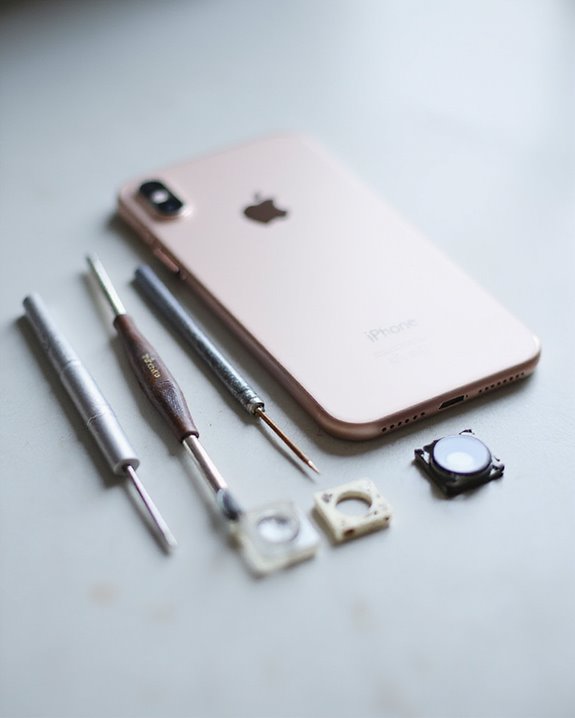
When considering camera lens replacement options for iPhones, consumers face markedly different cost structures depending on the repair method they choose. Official Apple repairs typically command premium pricing, with iPhone 12 Pro camera glass replacements costing approximately $199, while third-party services like Phonebulance offer alternatives starting from $89 for comparable models.
Global pricing variability stems from multiple factors, including currency fluctuations, import costs, and regional market conditions. DIY approaches present the most economical solution but require technical expertise and carry significant risk of causing additional damage. Economic factors within different countries further influence repair costs, with pricing disparities observed between online services and physical stores. Apple-authorized providers like Best Buy maintain consistent pricing with Apple’s official services, while independent repair shops frequently offer more competitive rates due to reduced overhead costs.
How Lens Replacement Affects Warranty Coverage
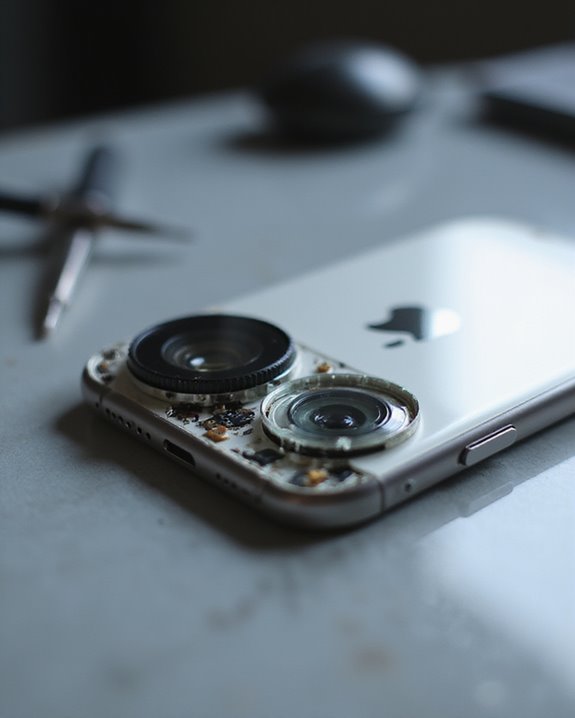
Understanding iPhone camera lens replacement requires careful consideration of warranty implications, as repairs can greatly impact coverage eligibility and future service options. The standard Apple Limited Warranty covers manufacturing defects for one year but excludes accidental damage unless it’s determined to be a non-impact stress crack.
When lens replacement occurs through unauthorized channels, users may forfeit remaining warranty protection and face potential Legal Implications for future repairs. Conversely, lens replacements performed by Apple or authorized service providers maintain coverage integrity and may qualify for Warranty Extensions of 90 days or the remainder of the original warranty period, whichever provides longer protection. For devices with AppleCare+, accidental damage repairs incur service fees but preserve full coverage. International consumers should note that regional consumer protection laws may provide additional rights beyond Apple’s standard warranty terms.
Common Mistakes to Avoid During Lens Replacement
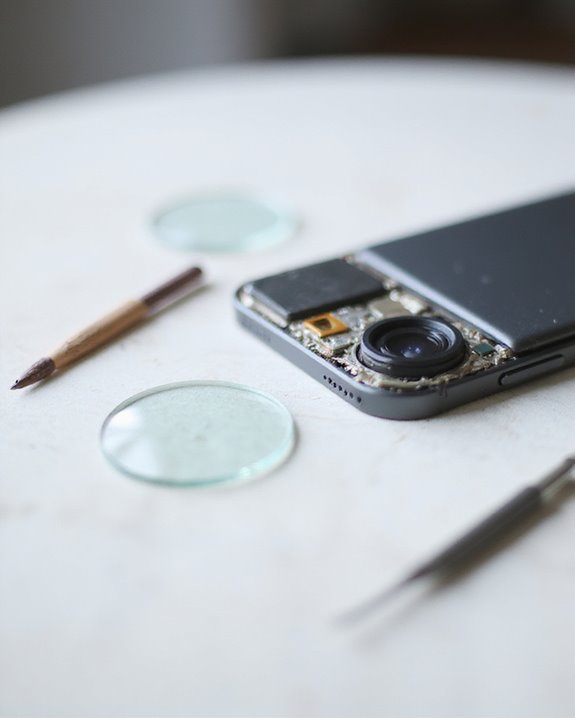
The lens replacement process for iPhones presents numerous technical pitfalls that can compromise both the functionality and longevity of the device’s camera system. Adhesive failures commonly occur when technicians select incorrect adhesive types, fail to properly clean residue before application, or apply uneven pressure during the curing process. The resulting improper seals can lead to moisture ingress and optical distortions that degrade image quality.
Component mishandling represents another critical area of concern, with technicians inadvertently causing damage by touching camera sensors, scratching lens coatings with metal tools, or damaging flex cables during disassembly. Proper alignment presents additional challenges, as mismatched lens curvature or incorrect seating depth can result in focus discrepancies and case compatibility issues, while inadequate thermal management during installation risks permanent damage to sensitive optical components.
Aftermarket Vs Original Parts: Quality Considerations
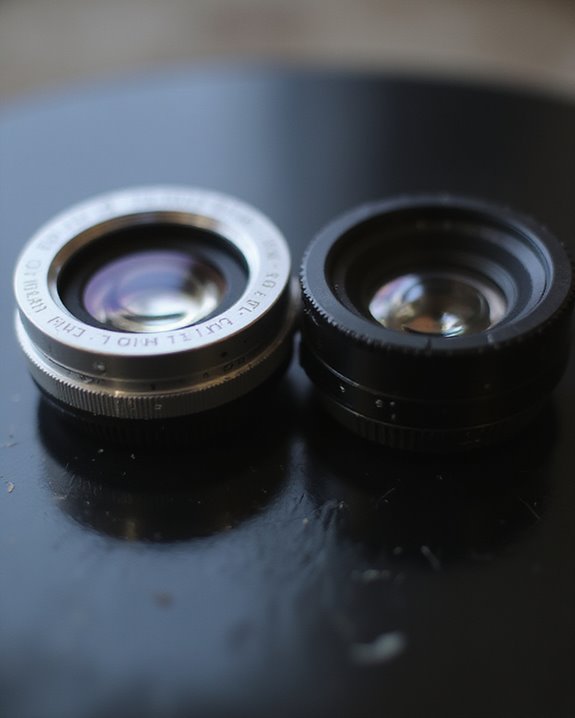
Beyond handling the technical challenges of lens replacement, iPhone owners must carefully evaluate the significant differences between aftermarket and original camera components. Original Apple parts consistently deliver superior performance, image quality, and durability compared to aftermarket alternatives, which often compromise on these aspects despite their lower cost.
Authenticity verification becomes vital when sourcing replacement parts, as OEM components—whether new, used, or refurbished—maintain professional standards and iOS compatibility that aftermarket parts frequently lack. Third-party cameras commonly suffer from auto-focus issues, uneven soldering, and potential software incompatibilities with future updates. User satisfaction generally correlates directly with part quality, with genuine components providing reliable performance and better long-term value. When considering repairs, consumers should weigh immediate cost savings against potential performance degradation, compatibility problems, and safety concerns that may arise from non-genuine parts.
Frequently Asked Questions
Can Lens Replacement Affect My Iphone’s Water Resistance?
Yes, lens replacement can compromise an iPhone’s water resistance if not performed correctly. Proper lens sealing is essential to maintain the device’s original water resistance rating after any camera lens replacement.
How Long Does a Typical Camera Lens Replacement Take?
Over 75% of simple lens replacements are completed within one hour. A typical iPhone camera lens replacement takes 30 minutes to 2 hours, depending on repair duration factors and technician expertise level.
Will a Replaced Lens Have the Same Photo Quality?
Replacement lens quality varies based on source. Using OEM parts typically maintains lens sharpness and color fidelity, while third-party replacements may show noticeable differences in image quality depending on manufacturing standards.
Can Lens Damage Affect Other Camera Components Over Time?
In a curious twist of physics, lens damage can indeed lead to Component Wear and Sensor Deterioration over time. Moisture, dust infiltration, and misalignment may gradually compromise internal camera components if left unaddressed.
Are There Temporary Fixes Before Getting a Lens Replacement?
Temporary fixes include applying lens tape or protective film over damaged areas, cleaning the lens properly, adjusting camera settings, switching between available cameras, and keeping the device dry until professional replacement is possible.





